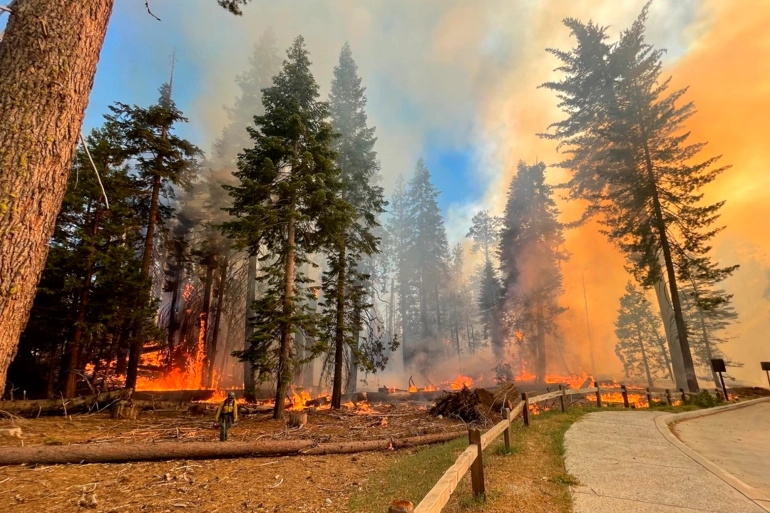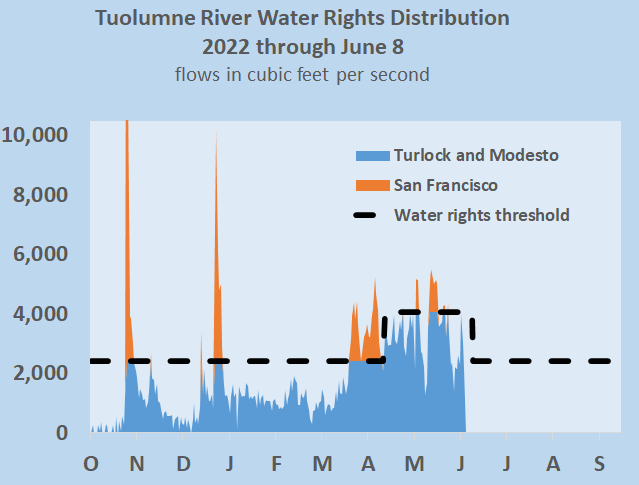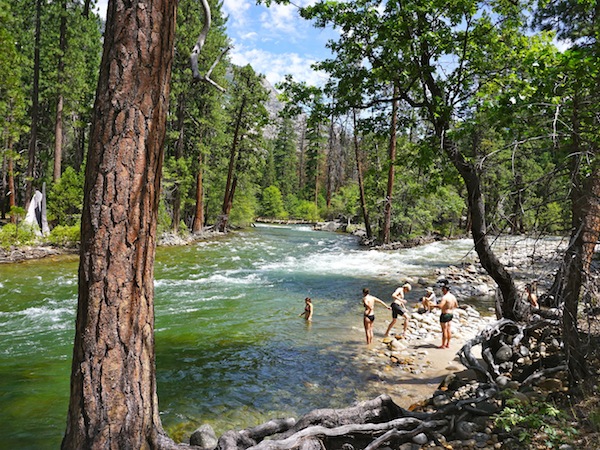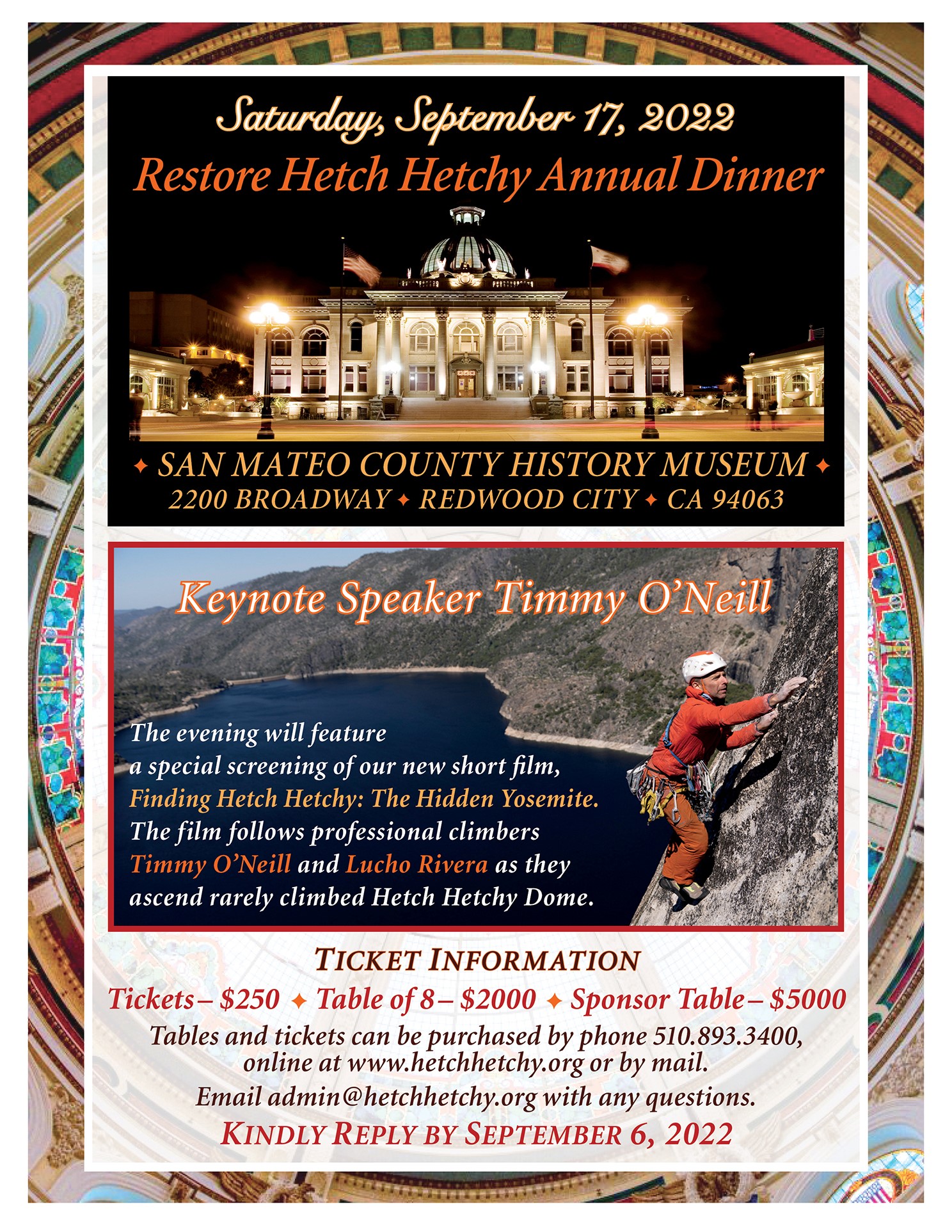

Please join us for our 2022 Annual Dinner. The San Mateo County History Museum is a former county courthouse, and a spectacular venue. We will screen Finding Hetch Hetchy (see clip) , hear from the dynamic Timmy O’Neill and more.

“Lusty Vigor” in the Mariposa Grove
“To look upon a tree that antedates the Christian Era; that was in lusty vigor when Rome was founded; that is older than the Iliad, is a thing not to be passed over lightly. I came down from the mountain feeling as thought I had communed with the monarchs of the classic days.” – future President James Garfield in 1875

A firefighter walks near the Mariposa Grove as the Washburn Fire burns in Yosemite National Park, California, July 7, 2022 [National Park Service via AP Photo]
Historically, these magnificent trees have been resistant to fire over the millennia. But the plethora of devastating fires in California in recent years is scary stuff, and giant sequoias are true treasures. May they survive and continue to thrive.
And a huge thank you to the brave and hard-working firefighters!
—- President Garfield is among those inspired by his visit to the Mariposa Grove in 1875. A recount of this historic trip, originally posted on this blog two years ago, is below.
James A. Garfield of Ohio was elected to Congress in 1862. In his first term he voted on the unprecedented 1864 Yosemite Grant, later signed by President Lincoln, to cede Yosemite Valley and the Mariposa Grove to California “upon the express conditions that the premises shall be held for public use, resort and recreation.”
In 1871, with the Republican Party in control of both houses of Congress as well as the Presidency, Garfield was named head of the Appropriations Committee. (For those who may not know, the Appropriations Committee controls where the money goes.) James Garfield was one of the most powerful men in Washington.
That all changed during the midterm elections of 1874. In the biggest ever “flip” of the House, the Republicans lost 96 of their 203 seats. Garfield suddenly went from being one of the most powerful men in Washington to being just one of 293 Congressmen.
So what did James Garfield do? He went to Yosemite!
Garfield hopped aboard the transcontinental railroad, completed only six years earlier, and traveled to California. He then took another train to Merced, a stagecoach to Mariposa and finally traveled by horseback to what is now Yosemite National Park.
James A. Garfield was impressed by what he saw, but felt he was unable to put it all in words:
“(Yosemite) is one of the few things I have ever examined which has not been over praised. All description fails adequately to exhibit its greatness.”
Upon visiting the Mariposa Grove, Garfield wrote:
“To look upon a tree that antedates the Christian Era; that was in lusty vigor when Rome was founded; that is older than the Iliad, is a thing not to be passed over lightly. I came down from the mountain feeling as thought I had communed with the monarchs of the classic days.”
Garfield’s view of Yosemite Valley came as a snow flurry subsided. He wrote:
“After a sharp shower of ten minutes the sun burst forth in full splendor disclosing the wonderful beauty of Bridal Veil Fall and the grand doorway to the Yosemite formed by the El Capitan on the left and the Cathedral Rocks on the right.”
In a letter to his family Garfield wrote:
“Tell Mamma that in my late letters I have spelled it as two words, but I was wrong. It is only one word, Yosemite, and is pronounced Yo-sem-i-te, four syllables, accented on the second.
James A. Garfield traveled to Yosemite in 1875, five years before he was elected president of the United States. Many Presidents have visited Yosemite while in office, including Rutherford Hayes, Theodore Roosevelt, William Taft, Franklin Roosevelt, John Kennedy and Barack Obama.
No Presidents have visited Yosemite’s Hetch Hetchy Valley, but several Secretaries of the Interior have, including Richard Ballinger (Taft), Donald Hodel (Reagan) and Ryan Zinke (Trump). Secretaries James R. Garfield (Roosevelt, and son of President James A. Garfield) and Franklin Lane (Wilson, and former City Attorney for San Francisco), both of whom played key roles in damming Hetch Hetchy, never visited Hetch Hetchy.
Yosemite, including Hetch Hetchy, is rich in American History. Restore Hetch Hetchy is committed to writing the next chapter.
Much of the information above was derived from material posted on the internet by Ephriam Dickson, who researched Garfield’s trip via the Library of Congress. Our thanks to Mr. Dickson.

The life, legacy and counsel of Jonas Minton

Jonas doing a “nosestand” in his kayak on the American River.
Environmentalist Jonas Minton passed on June 22, as a result of complications following heart surgery.
Jonas was most recently a water policy advocate for the Planning and Conservation League, where he was known for his knowledge, wisdom, integrity and good humor. He was never afraid to share his strong views about how water should be better and more fairly managed, nor to offer creative solutions.
Jonas also well understood the essential needs of cities and farms. He served as the Executive Director of the American River Water Forum, where he oversaw the sharing of the river between environmental uses and regional water agencies. Jonas also served as a Deputy Director of California’s Department of Water Resources (DWR).
While he was at DWR, a Hetch Hetchy meeting was scheduled in the Director’s conference room. Jonas stunned the small crowd by bursting through the back door, operatically bellowing “Yo Ho, Blow the Dam Down”. We restoration advocates were mightily amused; others not so much.
Most impressively, Jonas balanced passion with realism – he understood success required hard work and patience, and he was determined to have fun along the way. And, as he explains in the short video interview below, Jonas never demonized his adversaries – after all, he hoped to come to agreement with them down the road. Jonas’ spirit and counsel inspire us at Restore Hetch Hetchy. May he rest in peace.

California’s historic drought curtailments: “very deep” or no change on Tuolumne?

Early season storms provided substantial water to San Francisco under their junior water rights on the Tuolumne River. By the second week of June, however, the snowpack has largely melted and none of the river’s flow will likely be available to the City anyway – so the State Board’s curtailment order is likely to have no effect on its supply. Overall, San Francisco is doing pretty well water supply-wise this year, far better than most of California.
Due to our ongoing serious drought, on June 7 the State Water Board expanded its “Delta Watershed Curtailment Status List” to include San Francisco’s water rights on the Tuolumne River as well as some rights of the Turlock and Modesto Irrigation Districts. Erik Ekdahl, deputy director of the agency’s Division of Water Rights, described the restrictions — known as curtailment orders — as “significant” and “very deep.”
The story was covered with provocative headlines by both the Sacramento Bee (California tells San Francisco, Valley farmers to halt water diversions as drought worsens) and the San Francisco Chronicle (California orders thousands of farms and cities, including San Francisco, to stop pumping water during drought).
It does not appear, however, that the curtailment order will have any effect on San Francisco, and it may not even have any effect on the Turlock and Modesto Irrigation Districts (together, Turlock and Modesto use about 4 times as much Tuolumne River water as San Francisco and its Bay Area customers).
First, note that the order applies only to the limited snowmelt that still remains, not to water already stored in reservoirs or underground. Second, it’s highly unlikely that any river flows for the remainder of the water year would be available to San Francisco under their rights – the natural flow of the river would need to be over 2416 cubic feet per second (it’s possible but highly unlikely to be at all significant, see chart above). And thanks to the large storms earlier in the year, San Francisco is doing pretty well water supply-wise, far better than most of California.
It’s also not clear that the curtailment order will have any effect on the Turlock and Modesto Irrigation Districts. While some of the Districts’ water rights are curtailed, their longstanding “riparian” rights are not. See table below – extracted from the State Board’s massive spreadsheet, which identifies curtailment orders for 4571 out of the 16472 listed water rights in the Bay-Delta watershed.
No doubt many water rights in the Central Valley will indeed be affected, so the little flow available will go to those with the most senior water rights, and perhaps some will be left over to provide a sliver of relief for the Bay-Delta.
In many years, California’s cattywampus water rights system does not work very well for San Francisco. This year, with a significant ongoing drought, the City and its customers in other Bay Area cities are doing reasonable well.
| Principal Water Rights on the Tuolumne River | ||
| Application ID | Primary Owner | Curtailment Status (Effective 6/8/2022) |
| S002635 | SAN FRANCISCO | Curtailed |
| S002636 | SAN FRANCISCO | Curtailed |
| A014126 | TURLOCK I D & MODESTO I D | Curtailed |
| A014127 | TURLOCK I D & MODESTO I D | Curtailed |
| S013848 | TURLOCK IRRIGATION DISTRICT | Not Curtailed |
| S013849 | TURLOCK IRRIGATION DISTRICT | Not Curtailed |

Spring 2022 Newsletter – Keeping Promises Update and more

Restore Hetch Hetchy’s Spring 2022 Newsletter is available online. If you’d like a hard copy and have not received one, send your name and address to admin@hetchhetchy.org.
Included are:
- An update of our Keeping Promises campaign, discussions with the Park Service about extending access at Hetch Hetchy and building a short new trail to the top of Tueeulala and Wapama Falls;
- The premiere of Finding Hetch Hetchy, starring world-class climbers Timmy O’Neill and Lucho Rivera – available online soon;
- How restoring Hetch Hetchy differs from the Bay-Delta Plan when it comes to delivering water to California’s water cities and farms;
- Restore Hetch Hetchy’s role in removing signage in Yosemite Valley that was inaccurate and offensive to Native Americans;
- Tiffany Rosso, our awesome new Director of Development;
- Our upcoming Annual Dinner, September 17 at the San Mateo County History Museum; and
- Why you should visit Hetch Hetchy this year.

Three strikes for San Francisco

Hetch Hetchy Reservoir not only drowns a valley, it cuts off access to the surrounding canyon.
We’ve said it a million times. Restore Hetch Hetchy understands water storage is essential and that we do need dams (as well as improved groundwater storage). We simply don’t believe an iconic glacier carved valley in Yosemite National Park is the the right place for a dam and reservoir – especially when there are alternatives for storing the water elsewhere.
Dams do provide benefits. In California and the semi-arid west, dams store water from winter rains and spring snowmelt for delivery to cities and farms in summer and fall, as well as for carryover supplies in case the following year is dry. Dams also make it possible to generate hydropower. And many dams (although not O’Shaughnessy Dam at Hetch Hetchy) are required to maintain space for flood control.
In most cases, dams and reservoirs are managed to provide public benefits beyond water supply, hydropower and flood control. These benefits include:
- Reservoir-based recreation – swimming, fishing, camping etc.
- Healthy fish populations – by releasing sufficient instream flows for spawning and rearing downstream – sometimes to mitigate for the loss of spawning habitat caused by their construction, and
- River-based recreation – by releasing flows in conjunction with opportunities for rafting, canoeing and kayaking.
Even given Congress’ unprecedented permission to build a dam in national park, with regard to these other public benefits – San Francisco has struck out.
Strike 1: As we have explained at length in Keeping Promises: Providing Public Access to Hetch Hetchy Valley, Yosemite National Park, San Francisco committed to provide substantial access to the Hetch Hetchy area if it would be allowed to dam the valley, The City then reneged on those promises. Today, a paucity of trails and the City’s refusal to consider a non-polluting electric tour boat prevent visitors to Yosemite from accessing the backcountry in their national park. (East Bay MUD, for example, provides rental canoes and allows camping at its Pardee Reservoir.)

Backpackers frolic in the hard-to-reach Grand Canyon of the Tuolumne (Photo: Outdoor Adventure Club)
Strike 2: San Francisco continues to resist providing additional flows to help downstream fisheries. Along with other water interests on the Tuolumne River, San Francisco has declined to sign even the Newsom Administration’s (compromise) voluntary agreement to provide modest flows and funds to improve spawning habitat. The agreement was signed by a multitude of water agencies, including the largest in the Central Valley and the Metropolitan Water District of Southern California. A plethora of prominent environmental and fishing groups is applying pressure on San Francisco to provide additional water for downstream fisheries.

Chinook salmon (Photo: National Park Service)
Strike 3: In the wake of California’s overabundance of solar power during sunny afternoons, San Francisco has abandoned its long-standing practice of releasing hydropower from Cherry Reservoir on a schedule to benefit whitewater rafting and kayaking on the very popular “Lumsden” stretch of the Tuolumne River. A few miles north on the American River, the Sacramento Municipal Utilities District is abiding by its agreement to provide recreational flows below Chili Bar Dam.

The Tuolumne is a wonderful whitewater experience. Photo: Whitewater Voyages
Our mission is to return the Hetch Hetchy Valley in Yosemite National Park to its natural splendor ─ while continuing to meet the water and power needs of all communities that depend on the Tuolumne River. We can then return to the people Yosemite Valley’s lost twin, Hetch Hetchy – a majestic glacial-carved valley with towering cliffs and waterfalls, an untamed place where river and wildlife run free, a new kind of national park.
Even with the dam in place, however, San Francisco seems to be maximizing its own financial benefit at the expense of recreation and the environment – more so than other communities in California.
San Francisco needs to do better for the public on all fronts.

